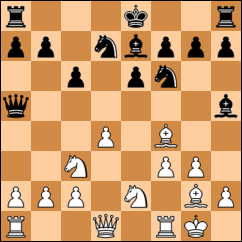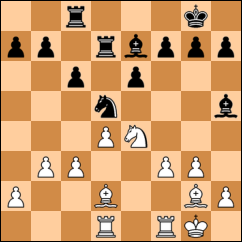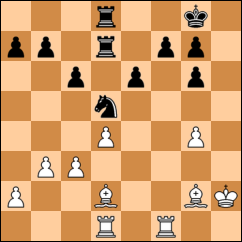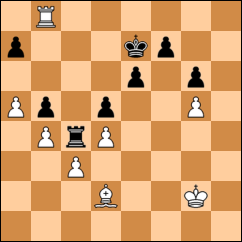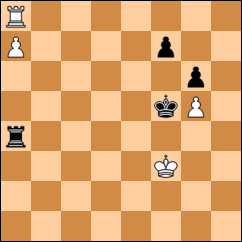Thursday 10 December 2015
White: T. Jefferies (118) - Black: K. Nevols
My opponent had made a good start to the championship so I decided for this game to fight it out in the centre and try to get an early initiative. (This was also my last game before the Christmas break so I hoped for a good 'end of term').
1. e4 e5
No Scandinavian this time. Let's get to grips in the centre.
2. Nf3 Nc6
3. a3?! Nf6
4. Nc3 d6
No reason to fear 4. .. Bc5 5. Nxe5 Nxe5 6. d4 Bxd4 7. Qxd4 Nc6 and then d6 but considering the trouble I got in the Maidstone game (Game Ten) I decided to give that line a miss and stay solid. Another line is 4. ... Bc5 5. Nxe5 Bxf2+ 6. Kxf2 Nxe5 7. d4 Neg4+ 8. Kg1 which disrupts the White kingside but I did not like the look of those central pawns.
5. h3 Be7
6. Bc4 h6
Stopping Ng5. I preferred this to 6. .. Nxe4 7. Bxf7+ although the computer likes it after 7. .. Kxf7 8. Nxe4 d5 and prefers 7. Nxd4 d5 8. Bd3 dxe4 9. Bxe4.
7. O-O O-O
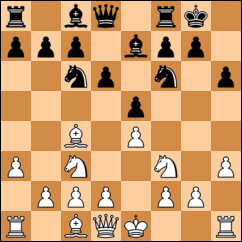
8. d3 Nh7
Now the troops are in their positions I decided it was time to think of a plan. And it is the old favourite of a kingside pawn push.
9. Nd5 Kh8
10. Nxe7 Qxe7
I was quite relaxed about exchanging this bishop, which was blocked in my pawns, for his good knight.
11. Be3
White might be thinking of a central pawn move himself working around d4, or ideas of Nd2 and f4.
11. ... f5
So I get on with it.
12. c3 f4
13. Bd2 Ng5
14. Kh2
To reinforce the h3 point.
14. ... Qf6
To free up the e7 square to bring the knight across, and also to keep Qg6 as a future option.
15. Nxg5 Qxg5
16. Qf3 Ne7
17. d4 Ng6
The initiative continues. No need to worry about the d4 and e5 pawns staring at each other. Oddly they will continue to do so for the next 33 moves.
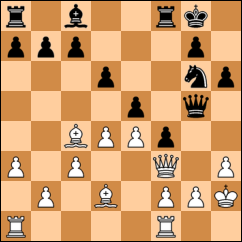
18. Rg1 Nh4
19. Qd1 Qe7
White has defended well although Black's attack was more a case of shove everything over there and see what happens. Now g5-g4 is in my mind.
20. f3 Rf6?
A mistake losing the initiative (which was petering out anyway). g5 should have been played and just clunking forward.
21. Be1
The point is that I now cannot play my intended 21. ... Rg6 because then 22. Bf2! and Qe1 is following trapping the knight.
(The computer disputes this and gives 21. ... Rg6 22. Bf2 exd4 23. cxd4 Qg5 and then if 24. Qe1 simply Nxg2 so instead White should play 24. Kh1 or 24. Bf1 and there is nothing further for Black to do. I did not see this line.)
21. ... Ng6
A humble retreat. White now has the edge and takes over the initiative with an advance in the centre and on the queenside. My aim now is to get the other rook in the game to finish development. The kingside is fine for now although my knight is now without work and I had to see what I could do in the centre.
22. Bf2 Be6
23. Bxe6 Rxe6
Taking with the rook so that the queen still defends the d8 square for the other rook.
24. Qb3 b6
I gave some thought to 24. .. c6 but did not like the initiative coming from 25. d5 with Rd1. I was aiming to close down the centre. Of course 24. ... Rb8 loses a pawn to 25. dxe5 and Bxa7.
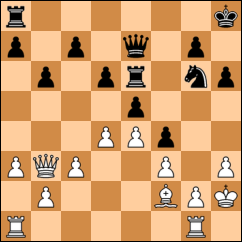
25. Qd5!
A powerful centralising move which I had underestimated. Qb7 and a queenside pawn advance is coming.
25. .... Rg8!
After much thought I came up with this defensive move of which I am quite proud. The plan is threefold - firstly, to defend along the eighth rank with the queen, secondly, to look for the right moment to throw in g5 to try to distract White and get some counterplay, and thirdly the rook is defended by the king to give him something to do and save someone else from the job.
26. b4
If 26. Qb7 a5 27. b4 axb4 28. axb4 Qd8 29. Ra7 Re7 30. Rga1 begins to look dangerous but I might be able to hold. I was thinking of 26. Qb7 c5 where one line is 27. Qxe7 Rxe7 28. dxc5 dxc5 29. Rgd1 intending to double up and play b4. Instead White plans to prevent any of this a5 or c5 nonsense and get on with the advance.
(Our electronic friend recommends 26. Qb7 exd4 27. cxd4 c5 28. Qxe7 Rxe7 29. Rac1 and then Rgd1).
26. ... Qe8
27. Qb7 Qb8
The conclusion of my defence plan. Exchanging queens would blunt White's attack. Maybe 27. a4 is more accurate but that is on its way anyway.
28. Qd5 Qc8
29. a4 Ne7
At last! The knight returns from unemployment to join the defence.
30. Qc4 g5
31. a5 h5
So far so good. I am answering White's play on one side with an advance in the other. Nigel Short once said 'If in doubt, push a pawn'.
32. axb6 axb6
(The computer states this is a mistake and prefers 32.... cxb6. Like me, it is worried about the upcoming Ra7. However, recapturing with the c-pawn never once occurred to me as I like pawn chains to be united and the a-pawn capture looks more natural).
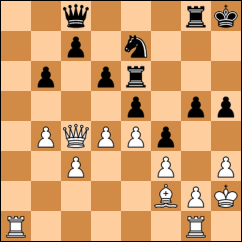
33. Ra8
A clever tactic. 33. .. Qxa8 34. Qxe6 Ng6 35. Qf6+ wins a pawn. I was more worried about 33. Ra7 and hoped I could make some sort of defence around 33. .. c6.
(Back to the computer who states I am right to be concerned. It does not like c6 and gives 33. .. c6 34. dxe5 b5 35. Qa2 dxe5 36. Bc5 with Rd1 and Ra8 as possible future attacks. It comes up with the ingenious move 33. .. g4!? 34. Rxc7 b5! - with one line being 35. Rxc8 g3+ 36. Kh1 bxc4 37. Rxg8+ Kxg8 38. Be1 d5 - a pawn down but mixing it in the centre).
33. .... Qd7
34. Rxg8?
I was relieved to see this. Again 34. Ra7 was my main concern. 34. .. Rc8 35. d5 Rg6 36. Bxb6 cxb6 37. Rxd7 Rxd4 38. Rxe7 Rxc3 39. Ra1 Rg7 40. Re6 Rd7 41. Ra6 looks like it a win for White.
34. .... Nxg8
35. Ra1 b5!
I was really pleased to find this move. Again I feared Ra7 but by dislodging White's queen from her excellent post, the attack is blunted. If now 36. Qd5 I intended c6.
36. Qa2 Rg6
Now I have a little time I can get back to the long forgotten plan of a kingside attack.
37. Qa8 g4
The plan is simply to open a line against the king.
38. Bh4 gxh3
Now I had planned 39. gxh3 Qg7 40. Ra2 exd4 (remember those two pawns who have been facing each other all this time). White could also play 40. d5 as Black's attack looks more dangerous than it actually is. After 40. ... Rg2+ 41. Kh1 Black has nowhere left to go and White threatens the fork Qe8.
39. g3?
Instead White tries to mix things up with a temporary pawn sacrifice but this is where the tide turns.
39. .... fxg3+
40. Bxg3 Qg7
41. Rg1 h4
Now if 42. Bf2 then simply Rxg1 and Qg2 checkmates.
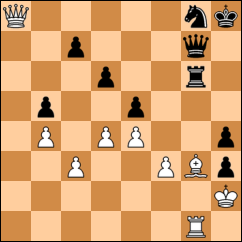
42. Qd8
I did not see this move. Now some thinking time resulted in a sequence where I could win a piece for a pawn.
42. ... hxg3+
43. Rxg3 Qf6
Nothing wrong with 43. .. Rxg3 44. Qh4+ Nh6 45. Qxg3 Qxg3+ 46. Kxg3.
44. Qxf6 Rxf6
45. Rxh3 Rh6
46. Kg3 Rxh3+
47. Kxh3
The last task is now to mop up. White has one pawn for the piece. I must not make any silly mistakes to lose or exchange too many pawns.
47. ... Kg7
Now if 48. dxe5 dxe5 49. Kg4 Kf6 50. f4 exf4 51. Kxf4 Ke6 White may be able to move the king over and exchange off the b-pawn but if I can hang on to the c-pawn I should be home and dry. As it happened, I was allowed to advance quicker than I anticipated.
48. Kg4 Kf6
49. Kh5 Ne7
50. Kg4 exd4
Exchanged at last.
51. cxd4 Nc6
52. d5 Nxb4
53. Kf4 Nc2
54. Kg3 Ke5
55. Kf2 Kf4
56. Ke2 Nd4+
57. Ke3 Nxf3
And now White resigned. A pleasing win after a tough battle.
